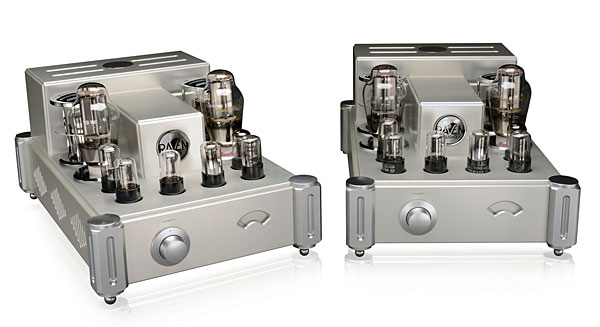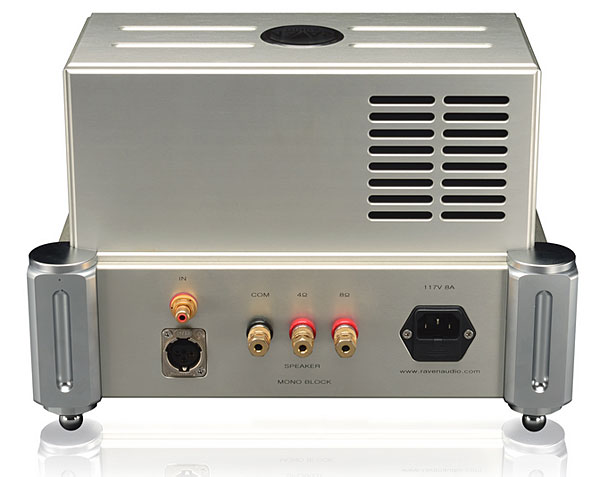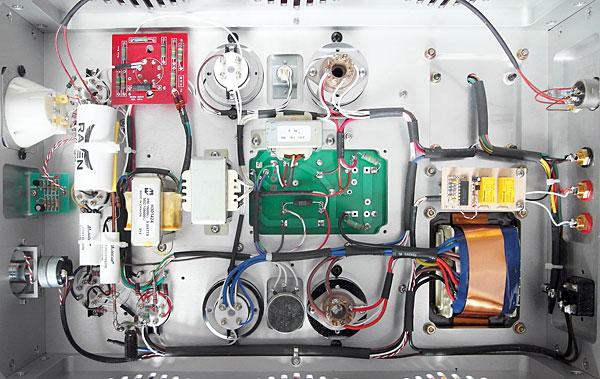| Columns Retired Columns & Blogs |
Listening #149 Page 2
A final note: While tooling around the website of Eclipse's parent company, I stumbled on Fujitsu Ten's corporate "behavior declaration," which stresses the concept of makoto (sincerity), and which pledges respect for human rights, prohibition of forced or child labor, fair conditions, a safe work environment, and the realization of true job satisfaction. Just like corporations here in the US. (That's a joke, son.)
Footnote 1: I was horrified when, in Downton Abbey's fourth season, haut was pronounced—by none other than Dame Kiri Te Kanawa!—to rhyme with goat. Ack.
Raven Audio Spirit Mk2 monoblocks
You may recall a reference, in Stereophile's May 2014 issue, to the Raven Audio Spirit 300B Reference Mono amplifiers. Like the ghosts in Henry James's The Turn of the Screw, the Monos hid in the margins of the story—the story, in this case, being my review of Raven's Spirit 300B Reference Stereo amplifier—yet never came into the open. As it happened, during a very brief trial in my system, both Spirit Reference Monos produced distressing noises, and a wisp of smoke curled, ectoplasm-like, from at least one of them. Those amps were subsequently replaced by their two-channel stablemate, which earned praise for good sound and respectable measured performance. And so the story might have ended.

But then came last year's New York Audio show in Brooklyn, bringing with it the chance to meet Raven Audio's Dave Thomson: the man who builds, in Texas, the electronics that his partner, S.E. Han, designs in South Korea. As you might imagine, Thomson's gladness at the positive review was outweighed by his distress at having sent me a pair of noisy troublemakers, at least one of which smoked. I couldn't help being impressed by Thomson, a former Nashville resident who for years earned his living as a singer-songwriter; thus, when the subject turned to That Review, I surprised both of us by spontaneously offering to have another go at the Spirit Monos—now available in an updated version called the Spirit Mk2 Monoblocks ($13,990/pair).
As happens to so many guests who visit my home in late fall, trouble befell Dave Thomson and his very lovely wife, Gabrielle—who had our shaky grenade of a terrier literally eating out of her hand—in the form of unpredicted snow. Yet we prevailed, and succeeded in getting the Spirit Mk2 Monoblocks out of their newly designed and eminently reusable cartons and into my listening room. Tubes were installed, plugs were plugged, and in due course we powered up the amps. Each made noise: one very quietly, the other much more audibly.
Brows furrowed. The ensuing flurry of activity culminated in our swapping, left for right, the proprietary Raven Audio AC cords—if only because, after having also swapped interconnects and reseated and swapped tubes, all to no avail, we were running out of ideas. Surprisingly, it worked: When we powered up the amps, the louder noise was completely gone. Then I powered down the amps and re-swapped the AC cords, this time noting that the fit between the cords and their IEC sockets was even more resistant and vague than is usual for such things (which is really saying something). Once again, the amps were powered up; once again, the more distressing noise was nowhere to be heard.

Thomson and I wondered: Had the noise originated from intermittent contact between wall current and amp? And I wondered: Had the same thing caused the noise and smoke during my first go-round with the Spirit Reference Monos? This morning, after two months of trouble-free and eminently musical performance from the Ravens, I can't help thinking that both may have been so.
Automatic Writing: For those of you who missed my review of Raven Audio's Spirit 300B Reference Stereo, a brief recap: Like its stereo sibling, the Spirit Mk2 Monoblock is a hand-wired amplifier that uses a push-pull pair of 300B direct-heated triode tubes, operated in auto-bias mode, to produce 26Wpc. Phase inversion and initial voltage gain are supplied by a pair of 12J5 dual-triode tubes, while three 12SN7 dual-triodes—the 12V version of the more common 6SN7—handle the other input-section chores. Incoming AC is set straight with a pair of 5AR4 rectifier tubes, in contrast with the solid-state rectification of the stereo model. Other niceties include a top-mounted hum pot for the 300B tubes, which are heated with DC rather than AC, and the use of an interstage transformer in place of a coupling cap between the driver tube and the output stage.
More conspicuous than any of the foregoing are the Spirit Mk2's size and weight: Two of them take up almost four square feet and weigh 128 lbs—forcing me to keep them on the floor rather than on my equipment rack. Fortunately, the contact points of the amps' adjustable feet are 14mm-diameter steel balls; today, that portion of my hardwood floor remains undamaged.
Late in the morning on the day after the Thomsons' departure, I spent some leisurely time with one of the greatest pop records ever made: John Lennon's Plastic Ono Band (LP, Apple SW 3372). Mine is the original copy I bought in 1971, with the washed-out, pale-green apple on the label, and which I've now given to my daughter, who just turned 17. (I still have the Mobile Fidelity Sound Lab LP of a few years ago, though that reissue lacks the original's directness and magic.) Before I parted with it, I washed the LP in the Audiodesksysteme Vinyl Cleaner—again, the word transformative came to mind—and played it on my usual system, with the Shindo Haut-Brion as the amp and the Altec Valencias as the speakers. I started with side 2, because I wanted to hear "Remember"—my daughter and I had recently rewatched V for Vendetta—and when I heard it through my system I cried a little. This was partly a reaction to setting off a nostalgia bomb when no one else was in the house, and partly because the music sounded good and right and angry and funny and propulsive and hard hitting, just as it was supposed to.

Then I powered down the old Haut (footnote 1), inserted the Raven monoblocks in the system, and when they'd warmed up I played that song again. It was pretty damn good. I can't honestly say I cried again, but maybe I had just one good cry in me that day. When I forced myself out of my reverie and made myself analyze the differences, I concluded that the Ravens didn't have quite the Shindo's sense of drive, but they did have good momentum, some swing, and lots of directness and impact. Best of all, through the Ravens I could still hear and feel how damn hard Lennon was pounding those piano keys: Especially during the intro, I could just about hear the instrument shake. And Klaus Voorman's bass in "Well Well Well" sounded monstrously good: It had cartloads of color and punch.
With emotionally challenging music and strenuously played piano in mind, I turned to the great, late John Ogdon and his 1969 traversal of Messiaen's Vingt regards sur l'enfant Jésus (LP, Argo ZRG 650-1). The strangely aggressive fugue Par lui tout a été fait, the strong left hand of which sounds at times almost like boogie-woogie, allowed the Raven to show off its good, big sense of scale and, again, its good sense of momentum. Color and texture were also outstanding with this track, and the Raven's musicality—its flow and general clarity of rhythmic purpose—were such that this very challenging music was easier to understand than through most other gear.
Unlike some 300B amps, the Raven was not a "happy lens." Cat Stevens's Teaser and the Firecat (LP, Island ILPS9154), an okay record with a barely tolerable lower-treble edginess, was still an okay record with a barely tolerable lower-treble edginess. Guitarist Mark O'Connor's tone was still just fair, Dan Crary's still clearly deficient. And the Spirit Mono didn't do the Fletcher-Munson thing: Every King Crimson album in my collection persisted in sounding best at higher-than-average playback levels, with which the Ravens were very comfortable.
And even at those higher-than-average playback levels, the Ravens maintained their poise and clarity. Listening to Bernard Haitink and the Royal Concertgebouw Orchestra's recording of Mahler's Symphony 3 (2 LPs, Philips 802 711/12AY), I was impressed with the clean sounds of horns and, especially, cymbals, the latter free from congestion and hash. More notable were the clean sounds of the timpani and bass drum early in the first movement—even more so than my Haut, which is something of a detail maven, the Ravens made it easy to hear and feel each individual application of mallet to skin, without smearing or overhang. The Spirit Mk2 was also superb at digging very subtle, soft details from the mix, such as the faint bass-drum rolls behind mezzo-soprano Janet Baker in portions of Elgar's Sea Pictures, recorded with Sir John Barbirolli and the London Symphony Orchestra (LP, EMI ASD 655).
In addition to a very pronounced noise that I mentioned earlier—apparently cured by more firmly seating the plugs of the AC cords in their sockets—at least one of the Spirit Mk2 Monoblocks produced a few subtler hums and zizzes. Those were all traced to a single 12J5 tube—which, like all of the dual-triode and rectifier tubes supplied with the Ravens, is an original, new-old-stock tube manufactured by the likes of RCA, Westinghouse, GE, or Sylvania. I recall, from conversations with Dave Thomson, his high regard for golden-era vacuum tubes, and I know the importance he places on letting his customers hear the Ravens at their very best. All the same, I can't help wondering if it isn't better to use, in a brand-new product line, a tube of which greater, newer, more consistently reliable stocks are easily available—even if an NOS tube might sound 10% better. Just sayin'.
I'm one of those listeners who believe there exist, among amplifiers, many different paths to glory—yet who has a special place in his heart for low-power, push-pull tube amps, especially monoblocks. A number of such models have impressed me over the years, and the realistically bold-sounding Raven Spirit Mk2 Monoblock has earned its place among them. Given that the Spirit Mono, even at $13,990/pair, is among the very better values in this heady field, and that Dave Thomson, like Leonard Cohen, is a man still working for your smile, I believe that this Raven deserves more than a second look and listen.
Footnote 1: I was horrified when, in Downton Abbey's fourth season, haut was pronounced—by none other than Dame Kiri Te Kanawa!—to rhyme with goat. Ack.
- Log in or register to post comments




































